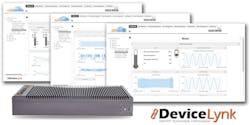Every time a consumer device-- such as a phone, television, or thermostat-- is updated, it gets better, smarter, and easier. So why do technology upgrades of industrial devices create more confusion and complexity? That’s the scene playing out right now with the onset of the Industrial Internet of Things (IIoT), which promises to add intelligence to machines and edge devices while seamlessly sharing data between systems and people. Industry pundits say that pulling this off will have a far-reaching impact on improving the productivity, efficiency, and operations of manufacturers around the world. The question now is: What’s it going to take to pull this off?
There are so many technology layers associated with IIoT, including embedded chips, network infrastructure, communication protocols, HMI interfaces, cloud connections, and big data repositories. All of this can “snap” together nicely when rolling out a greenfield project built entirely with IIoT-enabled systems from the get-go. But that’s not the reality. Today’s manufacturers are working with 20-to-30 year old assets and architectures. Slapping in a smart sensor means nothing if it’s unable to transmit the data it has collected, and maybe even analyzed.
There are IIoT frameworks under development from the Industrial Internet Consortium (IIC), the Smart Manufacturing Leadership Coalition (SMLC), and the German Industry 4.0 initiative. But there are organizational issues beginning to surface between these groups which makes one wonder if manufacturers will be forced to choose between multiple emerging standards in the future. All of this just adds to the confusion.
Can’t we find an easier way to enter the age of IIoT?
This was the basis of a recent discussion with executives from Industrial Software Solutions’ (ISS) Connectivity business. For the past two and a half years the Bothell, WA company has been developing DeviceLynk, a tool that turns a dumb device into a smart remote asset in plug-and-play form.
“We call it the DVR experience,” says Joe Ahladis, executive vice president of ISS. “We’ve taken the frustration out of [IIoT].”
Built using PTC’s ThingWorx IoT platform, DeviceLynk is like a black box that deploys at the remote site connecting to any industrial piece of equipment running a localized process, be it a PLC, sensor, or pump. The DeviceLynk Smart Server software utility works with over 200 industrial protocols as well the OPC UA specification that includes security permissions and encryption that is well-suited to IIoT applications. The DeviceLynk Smart Gizmo hardware facilitates device communication and data transmission. Each Gizmo can connect dozens of field devices with cellular, satellite, or Ethernet networks.
Another level of security is the fact that DeviceLynk is only monitoring, collecting, and transmitting information in a one-way direction from the device to where the information will be stored in the cloud using Amazon Web Services. Users log-in to their dashboard to view data that has been organized using situational awareness and a hierarchical drill-down structure delivering information that is easily understood by users to act upon.
The off-the-shelf black box that is DeviceLynk delivers an IIoT set-up in months, not years, and the companies currently using the products are seeing a return on investment in under a year, says ISS Connectivity’s managing director Adam Strynadka.
For example, one customer in Northern Canada is running fresh water filtration facilities with aging and diverse PLCs. There are over 20 facilities, each operating independently with individual physical reports gathered manually regarding water quality compliance. These reports are sent via e-mail to a central location for evaluation. The customer wanted to have near real-time automated monitoring of key water quality values from all locations simultaneously, as well as aggregated quality compliance reports. But they didn’t want to replace existing hardware and software due to resource and budget constraints.
DeviceLynk was deployed at each of their facilities with a connection to individual PLC/HMI systems. The DeviceLynk application was configured to pull the status on raw water intake, fire flow bypass, pretreatment, membrane skid, disinfection process, treated water output, and truck filling station. Now, a water quality report and membrane integrity test are made available on demand—anytime and anywhere.
“The only requirement is an HTML5-enabled web browser, which is on most modern smartphones and laptops,” Strynadka says.
It all does sound straightforward and trouble-free. But it also sounds very familiar. Flashbacks of conversations with utility companies using machine-to-machine connections to monitor energy usage and automate reporting enter my mind. How different is IIoT technologies from what manufacturers have already been using for remote monitoring in the field?
ISS executives would argue it is the open connectivity and a holistic approach that doesn’t require an integrator to redesign the system from front to back.
“At the end of the day the value to the customer is quicker decision-making and actionable information vs. standard reports,” Strynadka says. And that opens the door to conversations about big data, machine learning, and predictive analytics, which “frees customers from the old ways of doing things.”
If that’s true, the IIoT technology emerging today should be viewed as the catalyst for a seismic shift in more modern manufacturing methods tomorrow. ISS is just offering one—easier—way to do it.
About the Author
Stephanie Neil
Editor-in-Chief, OEM Magazine

Leaders relevant to this article:
